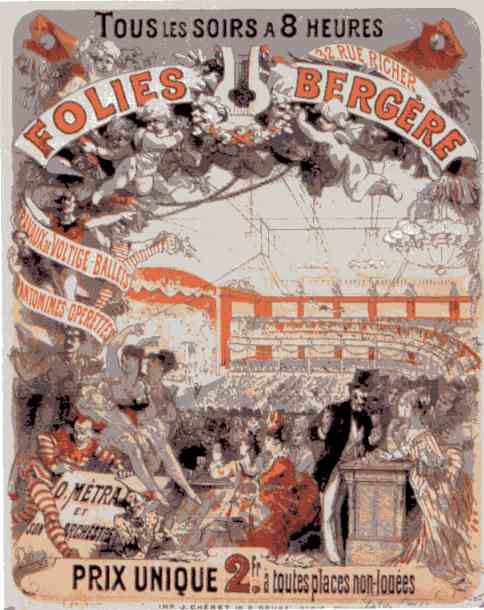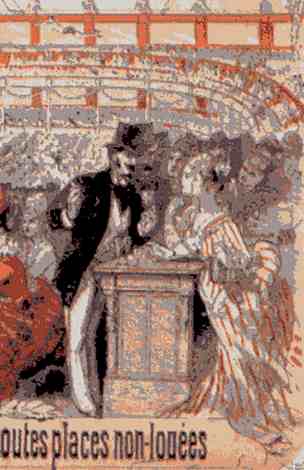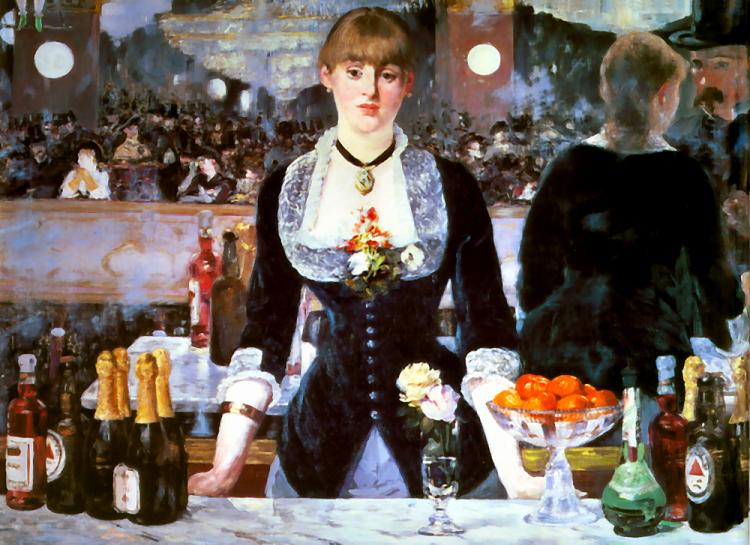I greatly admire the French Impressionists and one of my favourite paintings is Manet's masterpiece, A bar at the Folies-Bergère. Manet painted it during 1881/1882, at the very end of his life.
The artist
Édouard Manet was born into a rich Parisian family, the haute bourgeoisie of France, in 1832. He became close friends with Baudelaire, and his work is to some degree the pictorial counterpart of him. When Baudelaire proclaimed the modernity of vision and the need to substitute the reality of the present for the conventions of myth in art, he articulated what Manet believed. His art inspired the Impressionists, many of whom were his friends, but he refused to exhibit with them thereby hoping to influence and change the conservative Salon. He died in Paris in 1883. In Baudelaire's words "He is the painter, the true painter, who showed us how grand we are in our cravats and polished boots".
The location
 The first part of the Folies-Bergerère's name derives from the 18th century folie, an open air place where Parisians could drink, dance, and be generally entertained. This particular one began as, of all things, a department store in 1860, it is actually located at 32, rue Richer, near rue Bergère. Being in an ideal location close to the grands boulevards, in 1863 a salle des spectacles was added. This did so well that in 1869 the store section was dropped entirely.
The first part of the Folies-Bergerère's name derives from the 18th century folie, an open air place where Parisians could drink, dance, and be generally entertained. This particular one began as, of all things, a department store in 1860, it is actually located at 32, rue Richer, near rue Bergère. Being in an ideal location close to the grands boulevards, in 1863 a salle des spectacles was added. This did so well that in 1869 the store section was dropped entirely.
In 1871 Léon Sari took it over and completely refurbished it dividing it into two large spaces. One was the "Garden", an impressive hall with balconies. The other, where the painting places us, was a large horseshoe-shaped theatre with a balcony supported on columns (two of which are shown in the mirror behind the marble bar top). On the balcony the front two tiers were loges with a promenade behind them with bars spaced along the promenade. Manet places us in the promenade at the end of one of the limbs of the horseshoe-shaped balcony facing one of the large rectangular mirrors which covered the entire perimeter wall. This layout can clearly be seen in a publicity poster made in 1875 by Jules Chéret.
Chéret clearly shows the large mirrors under and above the balcony. Manet's bar is located where the words prix unique appear in the bottom foreground of the poster, at the end of the right limb as viewed from the stage. At each end of the balcony there was a similar mirror on the end wall at approximately 90° to the rest, the barmaid and her client in Manet's painting being boxed in by three mirrors, the third mirror being to her left and our right as we view her. If we look at the bottles on the left of the painting, we see the first bottle correctly reflected in the rear mirror, but then there is a reflection of a reflection of the whole group of bottles coming from the left mirror giving a 'correct' view of the bar rather than a direct mirror image. It seems to me that the painting is a combination of these three mirror images combined with artistic licence where Manet adopts a contemporary 19th century trick in fashion plates, where a distorted 'mirror' image is commonly used to show the rear of a dress or hat. Robert Herbert cites as an example the "Petit courrier des dames, Modes de Longchamp" Modes de Paris 20 April 1835.
Behind the barmaid's head in the painting we also see the reflection of one of the huge chandeliers which were spaced around, one of which can be seen on the right, above the head of the poster barmaid, with another three shown in the background.
Members of the Jockey Club and English bookmakers used to congregate every evening at the Folie-Bergère bars and in the painting, alongside champagne, we see bottles of English Bass beer with the familiar red triangle trademark. These were definitely not bars for the poor.
Run your mouse pointer over the painting to see the outlines of the mirrors on the opposite balcony and some reflected images.
The painting
The barmaid in the picture was a waitress from the Folies-Bergerère called Suzon, she posed for this painting in the artist's studio. Many modern art-historians have concluded that she, or at least the young woman depicted by Manet, was probably a prostitute. A few of the barmaids indeed may have been but it is unlikely that all were. As Robert L. Herbert puts it, "We can be quite sure that Blanche-Rose", an actress who started as a Folies-Begère barmaid and who definitely was not a whore, "and Suzon lived less than conventional lives than a proper bourgeoise, and that they might well have had lovers, or occasionally slept with a theatre manager, but between this and prostitution there is an enormous gap.". According to art historian Ruth Irskin, Suzon would only consent to sitting for the picture on condition that her boyfriend accompany her, hardly a likely request from even a part-time prostitute.
Sari no doubt encouraged his barmaids to flirt with the clients, and clients were led to expect this, as can be seen in the poster, but this is a far cry from giving ground to conclude that they were prostitutes.
In the painting we are faced with a figure which seems both aloof and remote, is she as she appears or is she as the man observing her imagines her to be? She stands in the narrow space between the marble top and the huge mirror. Reflected in the mirror we see the other side of the horseshoe-shaped balcony, directly facing another similar huge mirror and an infinity of reflections. The bottom frame of the bar mirror is parallel with the bar, yet her reflection is to the right.
The man has to be standing where you, the viewer, are standing. Does he see her as a still life? Drink, available woman, flowers, fruit, drink, all on a par? Is the reality her rear view, unseen by the man, slightly plumper, more animated? Or are we viewing reality and he the fantasy? Manet, the flâneur, is playing a game with us. A man seated at the front of the far balcony stares at the viewer's back, both men ignore the show on our left and the daring acrobat on the trapeze, whose legs we just see in the top left of the painting and who can be seen in action in this enlarged detail of Chéret's poster.

Peter Ghiringhelli ©
For a contrary view see Did She or Didn't She? A study in Covert Prostitution, by Jennifer L. Smith.
The painting can be seen at Courtaulds Institute of Art, University of London, Somerset House, Strand, London WC2.
Chéret's poster is at the Musée de la Publicité in Paris.
Bibliography of works consulted:
Impressionism - Art, Leisure, & Parisian Society Robert L. Herbert, Yale University Press, 1988.
The New Painting - Impressionism 1874-1886, Charles S. Moffett, Richard Burton SA, Publishers, Geneva, 1986.
Impressionism, Edited by Ingo F. Walther, Taschen, 2002.
Gardner's Art Through The Ages, Kleiner, Mamiya, and Tansey, editors, 11th edition, Harcourt College Publishers, 2001.
Iskin, Ruth E. "Selling, Seduction, and Soliciting the Eye: Manet’s ‘Bar at the Folies-Bergere’." The Art Bulletin. March 1995 v77 p25-44.
